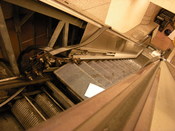Introduction:
Whether at the mall or at the airport, escalators are used on a regular basis. They are often taken for granted, but are actually the most expensive and biggest machines used by people regularly. Based on the inclined belt, the escalator is actually a very simple device. Stairs are pulled by rotating chain loops, making a very effective way for transporting a lot of people over a short distance. A specialized form of the escalator is moving ramps or sidewalks (travelators). These travelators move people and materials horizontally.
History:
The Escalator is based on the inclined belt invented by Jesse W. Reno in 1891. This had an incline of 25ð and a stationary handrail. An improved version introduced later in the year had a moving handrail. The father of the modern escalator is Charles D. Seeberger. He brought his design for the escalator to the Otis Elevator Company in 1899.
He had considered the names "traveling staircase", "inclined elevator", and "magic stairway" before he decided on escalator. He took the word elevator and added scala, which is Latin for steps. The escalator was first introduced at the Paris Exhibition of 1900, where it won first place.
How it Works:
As shown on the picture on the left, the escalator is basically a pair of chains that are looped around two pairs of gears. An electric motor turns the drive gears that are located at the top. The drive gears rotate the chain loops. The truss, a metal box between two floors, houses the motor and chain system. The chain loops move a series of steps, instead of a flat surface as in a conveyer belt. As you know from experience, the steps will always stay level. At the entrance and exit to the escalator (top and bottom), the steps...


